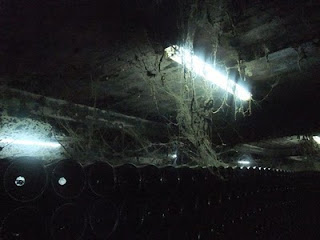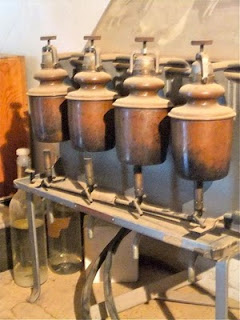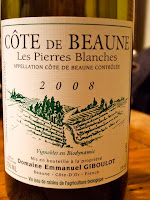
I suppose I should have guessed it from its idiosyncratic character but Chateau Musar is a natural wine. In fact judging from the cellars (above and below), I saw on my visit to the winery in the Lebanon last week ‘minimal intervention’ extends to not removing a single cobweb.

The winemaking operation has been certified organic since 2006. The domaine still works with traditional grapes such as Cinsault and Carignan that other wineries have given up on and with indigenous white varieties (see below). “I am addicted to Cinsault - it gives the silkiness and femininity to my wine, Cabernet, the backbone and Carignan the shape and muscles.” said Serge Hochar - a well honed line you feel he’s trotted out more than a few times before.
Yields in his Bekaa valley vineyards are kept low. The vines are unirrigated though with the lack of water this year they haven’t ruled it out for the future. “The soils of the Bekaa give concentration, intensity and a unique aroma. It’s a biodiverse environment with over 200 different kinds of plants.”
They use concrete tanks to ferment the wine “We’ve tried stainless steel but for our palate concrete works best.” No yeast is added. “The yeast is there before us and without us. Like oxygen” says Hochar in a typically elliptical way

After fermentation each variety is aged in Nevers oak then they are blended at the end of the third year after harvest in roughly equal proportions though the blend differs slightly from vintage to vintage. The wine is bottled then aged for a further four years in that cobwebby cellar. Hochar deliberately makes his wine in an oxidative style. “It’s part of the life of the wine. Like acidity it promotes longevity. I like brett (brettanomyces), I like brett - who cares?” he says defiantly.
Sulphur is only added to prevent odium in the vineyard and at bottling - he estimates each bottle contains less than 10mg free sulphur. “We do not fine or filter so the wine tends to throw a sediment after 6-7 years.”
Hochar insisted we kept the wine in our glass as we walked around from one section of the cellar to the other and upstairs to the tasting room, retasting it at every stage. “Wine is never the same - never, never, never ...”
The longevity of Musar rather demolishes the idea that natural wines don’t age. Hochar recommends reds should not be drunk for 15 years. “This is my opinion. I might be wrong . . . ” Actually I think he was spot on. My favourite red of the line-up - and this is not to decry the remarkable 1961 we tasted - was the 1995. Exactly 15 years old.
 Chateau Musar Red
Chateau Musar Red‘Chateau Musar makes every effort at producing totally natural wines letting each one develop its own character’ says the website, a warning that every vintage - possibly every bottle - will taste entirely different.
They suggest decanting 30 minutes to two hours before service and leaving them 2-4 weeks to settle after transporting them.
2003
The current release - with still 8 years to go before it’s ready to drink, according to Hochar but already full of rich dark dried fruit flavours - figs and preserved plums. A hot vintage. About £17.99-£18.99
1999
Very sweet, exotic, almost floral, ripe figgy with high acidity - the quality that helps Chateau Musar live ‘forever’ according to Serge Hochar. I picked up the Carignan more in this vintage. Another 3 years to go till it’s ready to drink About £24.95
1995
A classic Musar - slightly funky, silkily sweet, exotic, scented. Cinsault was the dominant grape in this blend. Although the older wines were impressively, fascinatingly complex this was my favourite wine of the line-up. Hard to get hold of. The Wine Society currently charges £50 a bottle.
The following two vintages were selected at random on the basis of the birthdates of two of our party
1974
Nose slightly seaweedy. Leathery (fruit leather) notes on the palate, quite surprisingly spicy. Long finish though slightly faded and dry. Can’t really agree with Serge’s comment that his older vintages ‘are old but do not show signs of age’ in this case
1961
Though faded at the edges still amazingly deep (garnet) in colour. We picked up a succession of flavours - root vegetables, at first, especially beets, sousbois (forest floor), shitake mushrooms, truffles, bacon, smoked Polish sausages, star anise, new leather (this came through after the wine had been exposed to air for a while) old Comté. A remarkable wine which helps to explain why Musar has developed its cult following
 Chateau Musar whites
Chateau Musar whitesI’ve always had issues with the Musar whites which are a blend of Merwah and Obeideh (ancestors of Semillon and Chasselas respectively. but on this occasion I found them stunning. Possibly I hadn’t tasted an old enough vintage. Or I was so hypnotised by the way Hochar was talking about them I took leave of my critical faculties. “If you open a bottle of white Musar and drink it every day for two weeks it will be better the last day than the first. My biggest wine is my white wine. It ages longer than the red.”
Interestingly these were served at room temperature.
2004
Characteristically waxy with an aroma of cooked apple (compote). Very spicy, high acidity. While more appealing that previous whites I’ve tasted it’s still not particularly rewarding to drink at this age. £16.50 a bottle from the Wine Society. (A few years ago you could have bought it for half that).
2001
Surprisingly rich in colour. Lush, opulent, waxy, nutty, honeyed but with that ever-present acidity. Grilled pineapple and a long spicy finish. Reminded me of Vina Tondonia aged white riojas. (Serge says it reminds him of the 1993 Haut Brion Blanc) Apparently he participated in a tasting of 26 cheeses with the famous French affineur Bernard Antony and this wine went with more than 12 of them. He also suggested it would go with lamb cooked with mint which I can imagine.
1993
Had suffered a fair amount of ullage. Very dark, rich colour. Spectacular nose - truffles, white flowers. Waxy, lanolin-like texture. Almost Sauternes-like, I note then Hochar compares it with Ygrec of d’Yquem) Still amazingly fresh. “Wines of this age can talk for hours” he says, mystically. My favourite white of the line-up
1989
Extraordinarily lush, opulent and rich for its age though more so on the front palate . Slightly thinner on the mid-palate with a slight note of bitterness on the finish. More quince than pineapple. Apparently it goes with caviar. I believe him.
What do you think of Musar. Does it appeal to you or do you think it’s overrated. If you like it what’s your favourite vintage?To arrange a tasting at Chateau Musar call 00961 9 925056 or 00961 9 925127 or email info@chateaumusar.com.lb.
 One of the ways we've been exploring the further reaches of artisanal wine is by buying mixed cases from specialist wine merchants. This bottle, which is surprisingly bright in colour for a 2004, came from our local Bristol merchant Vine Trail (at £17.95) and is made from 50 year old vines. The producer Gilles Berlioz farms organically and biodynamically and only adds sulphur at bottling.
One of the ways we've been exploring the further reaches of artisanal wine is by buying mixed cases from specialist wine merchants. This bottle, which is surprisingly bright in colour for a 2004, came from our local Bristol merchant Vine Trail (at £17.95) and is made from 50 year old vines. The producer Gilles Berlioz farms organically and biodynamically and only adds sulphur at bottling. 













